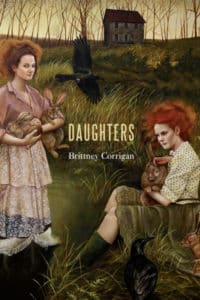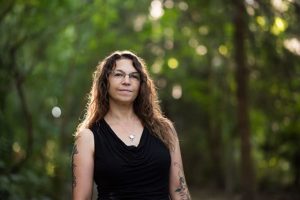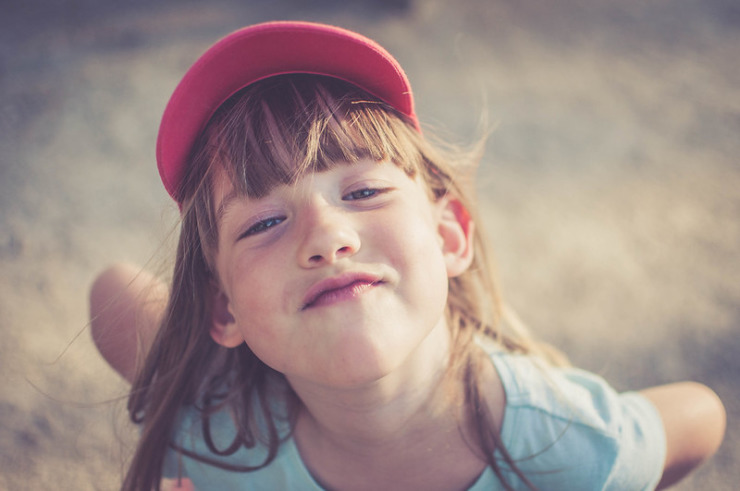Brittney Corrigan imagines a host of daughters
Poet Brittney Corrigan has produced one of the more creative and unusual collections of poetry I’ve read. She’s imagined herself as a daughter of a broad array of individuals – historical figures, figures from mythology and folklore, and figures from fiction and fairy tales. In describing these imagined daughters, she’s provided insights into the relationships, the subjects, and the works, cultural environments, or historical periods in which they’re situated.
What else do you call a collection like this but Daughters?
And then Corrigan takes her work an additional and large step further. Each of the 50 poems in the collection is six stanzas of six lines each. Try it for one poem, and then try it for 50. It is no easy task, and she pulls it off with wonder, creativity, a wry sense of humor, and deep understanding.
Do you want to know what it’s like to be the daughter of Bigfoot, a Yeti, a vampire, or a werewolf? How about the daughter of Alice of Through the Looking Glass fame, the Pied Piper, Goldilocks, or Dulcinea (as in Don Quixote)? Some unusual occupations are represented: ghost hunter, time traveler, alligator wrestler, storm chaser, and fire lookout. And mythical figures like Pandora, the Sandman, the swan maiden, the siren, and the minotaur. The collection even includes more prosaic subjects – the mortician, the surgeon, the taxidermist, the tattoo artist, the English teacher, and the cellist.
The daughters of all of them are here, speaking of their families, their lives, the excitement and burden of a well-known or celebrity parent, and their search for their own identity.
The daughter of Amelia Earhart is here, too, sometimes joining on her mother on an island after her disappearance and sometimes imagining being with her mother.
Amelia’s Daughter

I can see the island the way she does:
The palms and catchbird trees thick above
The beach, the lagoon-heart murky and blue,
The coral ring our hidden home. We are
Two phoenixes in the sun’s fierce heart.
Sometimes I put on my mother’s cap,
press the flaps against my ears as if
listening to the sea, but instead
it’s an echo of radio static. Trapped
in the leather like ghosts, the voices
talk to me in dashes and dots.
Sometimes I hold her goggles
to my eyes, dip my face into the coolness
of the sea to watch little sharks weave
circles in the shallows. Coconut crabs
back-tread in their callous shells. They
smell me and my pockets full of seeds.
I wish I could have ridden in the plane.
How I would like to fly with my mother
and her long-boned, pilot arm. How
I would like to see this island from above,
the smallness of it in the bigness of blue,
its bigness to the smallness of me.
My secret is I’m glad they haven’t found
us. Won’t ever know about me. I have
her freckles, her thick crop of hair. I wish
I had her eyes. My mother and I, we keep
company with the seabirds, the strawberry
hermits, the rats. The clicking of the crabs.
Sometimes pieces of her red-tipped plane
wash ashore. A lever or dial, a battered
aluminum patch. My mother and I, we sit
in the sun. I watch the skies, I guard her for myself.
My fingers smooth what’s left of her bleaching bones.
I am her Electra now. I open my arms like wings.

Brittney Corrigan
Each of the poems is like this, placing you in the middle of what’s happening and inviting you to take an unexpected look at the subject. And this being a collection of poems ostensibly by daughters, the subject is as much the mother or father as it is the daughter.
Corrigan has published three previous collections of poetry: Breaking, Navigation, and 40 Weeks. Solastalgia, her collection about climate change and extinction, will be published by JackLeg Press in 2023. Her poems have been published in numerous literary journals and magazines. A native of Colorado, she lives in Portland, where she works for Reed College (from which she also graduated). Corrigan is also working on a short story collection.
Daughters is inventive, attention-holding, and, at times, provocative. Using the device of a daughter, Corrigan leads you into viewing her subjects in a very different light from what you may have previously understood. And she gives you 50 poems that are simply a pleasure to read.
Photo by Frederique Voisin-Demery, Creative Commons, via Flickr. Post by Glynn Young.
How to Read a Poem uses images like the mouse, the hive, the switch (from the Billy Collins poem)—to guide readers into new ways of understanding poems. Anthology included.
“I require all our incoming poetry students—in the MFA I direct—to buy and read this book.”
—Jeanetta Calhoun Mish
- Poets and Poems: Michelle Ortega and “When You Ask Me, Why Paris?” - April 10, 2025
- Robert Waldron Imagines the Creation of “The Hound of Heaven” - April 8, 2025
- Poets and Poems: Luci Shaw and “An Incremental Life” - April 3, 2025


Leave a Reply